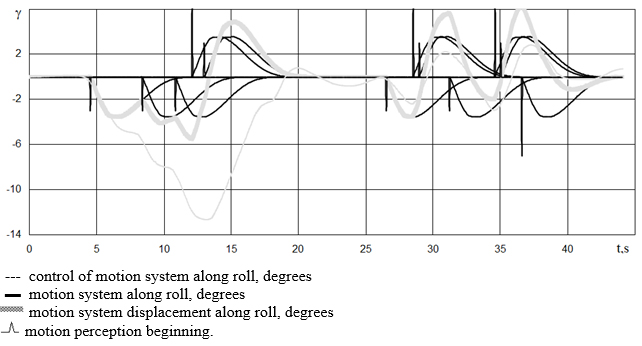Consideration of the problem of motion cueing along angular degrees of freedom on flight simulators
DOI:
https://doi.org/10.15587/2706-5448.2023.293498Keywords:
flight simulator, motion system, motion cueing, character, direction, duration, intensity and time of motion perceptionAbstract
The object of research is motion cueing along angular degrees of freedom on flight simulators of non-maneuvering aircraft. One of the most problematic places is lack of statement and effective solution of the problem to ensure high-quality motion cues along angular degrees of freedom on flight simulators, which would correspond to motion cues along angular degrees of freedom in real flight with the same control actions. In the course of the research, on the basis of the peculiarities of human movement perception, a set of characteristic attributes of perception of motion cues is determined: character, direction, duration, intensity and time of motion perception (according to Gibson’s perception theory). Based on the system approach principles, the mathematical formulation of the solution to the problem of motion cueing along angular degrees of freedom on flight simulators of non-maneuvering aircraft is used. Such approach made it possible, taking into account the existing constructive resource of flight simulator motion system, to bring as close as possible motion cueing along angular degrees of freedom on flight simulators of non-maneuvering aircraft to motion cues along angular degrees of freedom in real flight with the same control actions. Due to this the character and direction of motion cues fully correspond to the real motion cues, the difference between the perception time of motion cues on airplane and simulator is minimal and meets the current requirements. The duration and intensity of the motion cue perception on simulator are proportional duration and intensity of motion cue perception on airplane. Such approach significantly improves the quality of training and retraining of pilots on flight simulators. Implementation of the developed problem formulation on aircraft simulators, in particular on An-74TK-200, showed its high efficiency. In the future, the proposed approach can be used on flight simulators of aircraft developed in Ukraine and modernization of operated flight simulators.
References
- Predvaritelnaia otcenka vliianiia podvizhnosti aviatrenazhera na protcess pilotirovaniia i analiz sposobov upravleniia dvizheniem otseka (1970). Otchet NII/TcAGI, No. GR 015110-1, inv. No. 655. Moscow, 34.
- Aleksandrov, V. V., Sadovnichii, V. A., Chugunov, O. D. (1986). Matematicheskie problemy dinamicheskogo modelirovaniia poleta. Moscow: MGU, 181.
- Bussolari, S., Young, L., Lee, A. (1989). The use of vestibular models for design and evaluation of flight simulator motion. Flight Simulation Technologies Conference and Exhibit. Washington, 86–93. doi: https://doi.org/10.2514/6.1989-3274
- Hall, J. R. (1989). The Need for Platform Motion in Modern Piloted Flight Training Simulators. Tech Memo FM 35. Royal Aerospace Establishment. Bedford, 16.
- Heintzman, R. J. (1996). Determination of Force Cueing Requirements for Tactical Combat Flight Training Devices. SIMTEC, Inc., ASC-TR-97-5001, 153.
- 14 CFR Part 60 (2016). NSP Consolidated Version, 639.
- Davison, P. J. (2018). Motion in Flight Simulators – A story of Evolution. Suite D, 6/F. Ho Lee Commercial Building, 17.
- Chesebrough, D. (2000). The Link Flight Trainer. Binghamton, 12.
- Bürki-Cohen, J., Go, T. H. (2005). The Effect of Simulator Motion Cues on Initial Training of Airline Pilots. AIAA Modeling and Simulation Technologies Conference. AIAA-2005-6109. doi: https://doi.org/10.2514/6.2005-6109
- Longbridge, T., Burki-Cohen, J., Go, T. (2001). Flight Simulator Fidelity Considerations for Total Airline Training and Evaluation. AIAA Modeling and Simulation Technologies Conference. AIAA-2001-4425. doi: https://doi.org/10.2514/6.2001-4425
- White, A. D. (1994). The Impact of Cue Fidelity on Pilot Behavior and Performance. FDS Dept., Defence Research Agency. Bedford.

Downloads
Published
How to Cite
Issue
Section
License
Copyright (c) 2023 Volodymyr Kabanyachyi, Beycan Ibrahimoglu

This work is licensed under a Creative Commons Attribution 4.0 International License.
The consolidation and conditions for the transfer of copyright (identification of authorship) is carried out in the License Agreement. In particular, the authors reserve the right to the authorship of their manuscript and transfer the first publication of this work to the journal under the terms of the Creative Commons CC BY license. At the same time, they have the right to conclude on their own additional agreements concerning the non-exclusive distribution of the work in the form in which it was published by this journal, but provided that the link to the first publication of the article in this journal is preserved.







